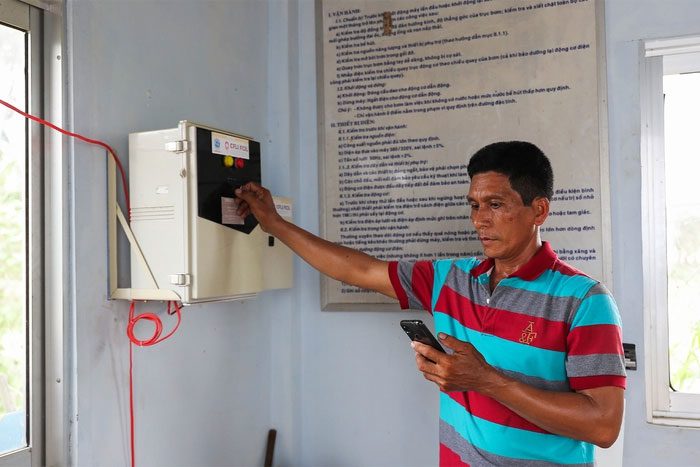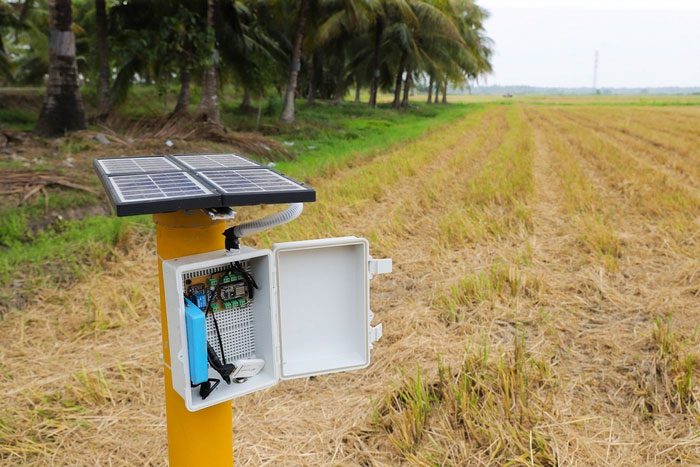In the heat of the dry season in Trà Vinh, rice farmer Thach Ren stands in a field recently harvested. The once lush green field has turned barren, covered in rice husks.
Ren, 43, who has witnessed the constantly changing landscapes of land and water along the Mekong River, is part of a small group of farmers testing a new rice cultivation method.
He is a member of the Phu Can Agricultural Cooperative, one of three cooperatives involved in a pilot project with a local university in Trà Vinh.
As climate change rapidly poses challenges to Vietnamese rice farmers, especially regarding water access, this project could provide them with a new direction.
Now, with just a simple push of a button, Ren can connect to a network of sensors and water pumps, linking him directly to his fields and helping him reduce the amount of water needed for rice cultivation.
“I just need to press the power button… to check the water level in the field,” Ren said.

In 2017, Trà Vinh University installed smart pumps for farmers like Thach Ren so they can use smartphones to check water levels in rice fields without needing to be on-site. (Photo: news.mongabay).
Vietnam is one of the largest rice producers in the world, with emerald-green fields resembling a chessboard. However, climate change is rapidly altering this landscape.
Ren sees evidence of this every day. He has been cultivating rice in Vietnam for over 20 years and believes it is time to try something new.
“I flipped a coin and tried a new technique,” he said.
This new technique is called “Alternate Wetting and Drying” (AWD). Faced with freshwater scarcity and increasing salinity, researchers and farmers are collaborating to implement a rice farming method that uses less water.
With the support of Trà Vinh University (TVU), farmers in the Phu Can Cooperative are experimenting with a technique that allows them to produce the same amount of rice while using up to 20% less water.
Ren is one of the first farmers to participate in the pilot project, and he reports that he now only needs to pump water 3 to 4 times each season, compared to the traditional method where he had to pump water every time the soil surface was slightly dry—typically about 10 times per season.
“The new method is much cheaper than the old one,” Ren noted.
Nam Dung, who has been farming all his life, “since the day I learned to hold a hoe.” This 46-year-old man joined after learning about the pilot project.
“Not only does it save water, but it also reduces the cost of purchasing water pumps. We can also decrease the amount of fertilizer needed, increase crop yields, and prevent rice plants from falling over and destroying the entire harvest,” Dung said.
Alternate Wetting and Drying involves flooding and draining the rice fields in quick succession. Instead of being continuously flooded, the rice fields are allowed to dry for several days before being flooded again. Farmers need to closely monitor their fields to determine when to irrigate again, aiming to use the minimum amount of water necessary to keep the plants healthy.

AWD has been tested and used in rice-producing regions around the world. (Photo: news.mongabay).
AWD has been tested and implemented in rice-producing regions worldwide for decades, including An Giang Province in Vietnam, but it is still new to farmers in this Mekong Delta region. Convincing farmers to switch to this new irrigation method, which may require more labor, has taken years.
Researchers at TVU have developed an app-based technology to help make AWD easier to implement, so farmers do not have to constantly monitor their fields. With funding from the World Bank and the Canadian Government, each AWD plot is equipped with a solar-powered sensor that reads groundwater levels every 5 minutes.
This data is transmitted in real-time to software, which then sends recommendations to farmers through the app, allowing them to control the water levels in their fields without needing to be there in person.

Each AWD plot is equipped with a solar-powered sensor. (Photo: news.mongabay).
“If I’m busy with other work and can’t get to the field, I just need to open the app and check the data there. I can be anywhere and just press a button,” Dung said.
The researchers launched this project after the worst drought in over a century hit southern Vietnam in 2016, devastating farms in the delta.
In 2017, the TVU team began training farmers on how to implement AWD through workshops. Mr. Diep Thanh Tung, one of the leading researchers at TVU, stated that the initiative has been implemented in three regions: Trà Vinh, Cần Thơ, and An Giang.
“This area is significantly affected, especially in rice production. Farmers would incur 100% losses if they do not know how to cope with that situation,” he said.


















































